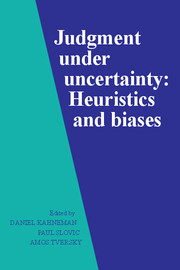Book contents
- Frontmatter
- Contents
- List of contributors
- Preface
- Part I Introduction
- Part II Representativeness
- Part III Causality and attribution
- Part IV Availability
- Part V Covariation and control
- Part VI Overconfidence
- Part VII Multistage evaluation
- Part VIII Corrective procedures
- 28 The robust beauty of improper linear models in decision making
- 29 The vitality of mythical numbers
- 30 Intuitive prediction: Biases and corrective procedures
- 31 Debiasing
- 32 Improving inductive inference
- Part IX Risk perception
- Part X Postscript
- References
- Index
29 - The vitality of mythical numbers
Published online by Cambridge University Press: 05 May 2013
- Frontmatter
- Contents
- List of contributors
- Preface
- Part I Introduction
- Part II Representativeness
- Part III Causality and attribution
- Part IV Availability
- Part V Covariation and control
- Part VI Overconfidence
- Part VII Multistage evaluation
- Part VIII Corrective procedures
- 28 The robust beauty of improper linear models in decision making
- 29 The vitality of mythical numbers
- 30 Intuitive prediction: Biases and corrective procedures
- 31 Debiasing
- 32 Improving inductive inference
- Part IX Risk perception
- Part X Postscript
- References
- Index
Summary
It is generally assumed that heroin addicts in New York City steal some two to five billion dollars worth of property a year, and commit approximately half of all the property crimes. Such estimates of addict crime are used by an organization like RAND, by a political figure like Howard Samuels, and even by the Attorney General of the United States. The estimate that half the property crimes are committed by addicts was originally attributed to a police official and has been used so often that it is now part of the common wisdom.
The amount of property stolen by addicts is usually estimated in something like the following manner:
There are 100,000 addicts with an average habit of $30.00 per day. This means addicts must have some $1.1 billion a year to pay for their heroin (100,000 × 365 × $30.00). Because the addict must sell the property he steals to a fence for only about a quarter of its value, or less, addicts must steal some $4 to $5 billion a year to pay for their heroin.
These calculations can be made with more or less sophistication. One can allow for the fact that the kind of addicts who make their living illegally typically spend upwards of a quarter of their time in jail, which would reduce the amount of crime by a quarter. (The New York Times recently reported on the death of William “Donkey” Reilly.
- Type
- Chapter
- Information
- Judgment under UncertaintyHeuristics and Biases, pp. 408 - 413Publisher: Cambridge University PressPrint publication year: 1982
- 3
- Cited by



